See also
Time capsules
Spacecraft
- Voyager
- Rosetta
- LAGEOS (satellite)
- Apollo 11 Lunar Module
- Pioneer 10 and Pioneer 11
Organizations
KEO is the name of a proposed space time capsule which was to have been launched in 2003 carrying messages from the citizens of present Earth to humanity 50,000 years from now, when it would re-enter Earth's atmosphere. Its name represents the three most frequently used sounds common to the most widely spoken languages today, /k/, /e/, and /o/. [1] Everyone was invited to contribute to the time capsule, and the organizers encouraged everybody to gather messages from children, senior citizens, and the illiterate so that every culture and demographic on Earth was represented. Moreover, the organizers were committed to not filtering the messages, stating "all the messages received, without undergoing any censorship, will be embarked aboard KEO." [2] The launch has been delayed several times due to major geopolitical shakeups, including 9/11 and the restructuring of the ESA. [2] As of 1 January 2021 [update] , no launch date has been confirmed.
The messages and library will be encoded in glass-made radiation-resistant DVDs. Symbolic instructions in several formats will show the future finders how to build a DVD reader.
The satellite has enough capacity to carry a four-page message from each of the more than six billion (as of the original 2009 deadline) inhabitants on the planet. [4] Once the satellite is launched, the messages will be made freely available on the web.
The satellite itself is a hollow sphere 80 cm in diameter. The sphere is engraved with a map of Earth and surrounded by an aluminium layer, a thermal layer and several layers of titanium and other heavy materials intertwined with vacuum. The sphere is resistant to cosmic radiation, atmosphere re-entry, space junk impacts, etc. For its first few years in orbit, KEO will sport a pair of wings 10 meters across that will aid in its spotting from Earth. As the satellite enters the atmosphere, the thermal layer will produce an artificial aurora to give a signal of the satellite's re-entry. The passive satellite will not carry any communications or propulsion systems. It will be launched by an Ariane 5 rocket into an orbit 1,800 km high, an altitude that will bring it back to Earth in 500 centuries, the same amount of time that has elapsed since early humans started to draw on cavern walls.
| Year | Event | Description |
|---|---|---|
| 1994 | The KEO satellite is first conceived | French artist-scientist, Jean-Marc Philippe, comes up with the idea for the KEO satellite. [5] [6] [7] |
| 1996 | Initial delay | The launch was delayed due to "restructuring of the French then European space industry (1996/1999)" [2] |
| 1998 | Technical feasibility first demonstrated | |
| 1999 | Message collection starts | Messages began to be collected and an initial launch date is set for 2001.[ citation needed ] |
| 2001 | Launch delayed to 2003 | The recession in the worldwide space activity from 2000 to 2002 and the attacks on the World Trade Center on 11 September 2001 caused the launch to be further delayed. [2] |
| 2003 | Launch delayed to 2006 | The reorganization of the French Space Agency and the failure of the qualifying launch of Ariane V pushed the launch date back to 2006. [2] |
| 2005 | ESA signs off on technical feasibility [8] | |
| 2006 | Launch delayed to 2007/2008 | In 2006, the launch was delayed again, due to "lack of enthusiasm of several partners due to the prolongations of the project". [2] |
| 2008 | Jean-Marc Philippe died | Jean-Marc Philippe died on 12 November 2008. Before his death, he held a degree in geophysics and also worked as a painter. [9] |
| 2008 | Launch delayed to 2010/2011 | The launch was delayed due to "restructuring of the data processing industry". [2] |
| 2009 | Original end of message collection | Deadline for message collection was extended to the end of 2014. The contribution deadline was originally 31 December 2009, but as of 2014 [update] , it has been extended to end of 2014. |
| 2011 | Launch delayed to 2012 | Launch was delayed due to "armed conflicts and political conditions of the world" [2] |
| 2012 | Launch delayed to 2013 | |
| 2013 | Launch delayed to 2015/2016 | |
| 2016 | Launch delayed to 2018/2019 | |
| 2018 | End of message collection [10] | |
| 2019 | Planned launch | Currently[ when? ] the KEO website cites 2019 as its launch, however, no actual date is set and information about its launch is vague. [10] [11] |
Time capsules
Spacecraft
Organizations

A spacecraft is a vehicle or machine designed to fly in outer space. A type of artificial satellite, spacecraft are used for a variety of purposes, including communications, Earth observation, meteorology, navigation, space colonization, planetary exploration, and transportation of humans and cargo. All spacecraft except single-stage-to-orbit vehicles cannot get into space on their own, and require a launch vehicle.

Atmospheric entry is the movement of an object from outer space into and through the gases of an atmosphere of a planet, dwarf planet, or natural satellite. There are two main types of atmospheric entry: uncontrolled entry, such as the entry of astronomical objects, space debris, or bolides; and controlled entry of a spacecraft capable of being navigated or following a predetermined course. Technologies and procedures allowing the controlled atmospheric entry, descent, and landing of spacecraft are collectively termed as EDL.

Spaceflight is an application of astronautics to fly spacecraft into or through outer space, either with or without humans on board. Most spaceflight is uncrewed and conducted mainly with spacecraft such as satellites in orbit around Earth, but also includes space probes for flights beyond Earth orbit. Such spaceflight operates either by telerobotic or autonomous control. The more complex human spaceflight has been pursued soon after the first orbital satellites and has reached the Moon and permanent human presence in space around Earth, particularly with the use of space stations. Human spaceflight programs include the Soyuz, Shenzhou, the past Apollo Moon landing and the Space Shuttle programs, with currently the International Space Station as the main destination of human spaceflight missions while China's Tiangong Space Station is under construction.

Vanguard 1 is an American satellite that was the fourth artificial Earth-orbiting satellite to be successfully launched, following Sputnik 1, Sputnik 2, and Explorer 1. It was launched 17 March 1958. Vanguard 1 was the first satellite to have solar electric power. Although communications with the satellite were lost in 1964, it remains the oldest human-made object still in orbit, together with the upper stage of its launch vehicle.
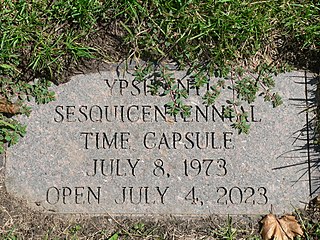
A time capsule is a historic cache of goods or information, usually intended as a deliberate method of communication with future people, and to help future archaeologists, anthropologists, or historians. The preservation of holy relics dates back for millennia, but the practice of preparing and preserving a collection of everyday artifacts and messages to the future appears to be a more recent practice. Time capsules are sometimes created and buried during celebrations such as a world's fair, a cornerstone laying for a building, or at other ceremonies.
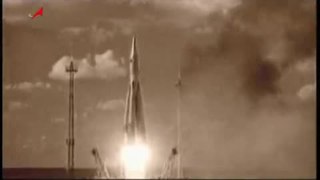
The Soviet space program was the national space program of the former Union of Soviet Socialist Republics (USSR), active from 1955 until the dissolution of the Soviet Union in 1991.

The Kármán line is an attempt to define a boundary between Earth's atmosphere and outer space, and offers a specific definition set by the Fédération aéronautique internationale (FAI), an international record-keeping body for aeronautics. Defining the edge of space is important for legal and regulatory purposes since aircraft and spacecraft are subject to different jurisdictions and are subject to different treaties. International law does not define the edge of space, or the limit of national airspace.
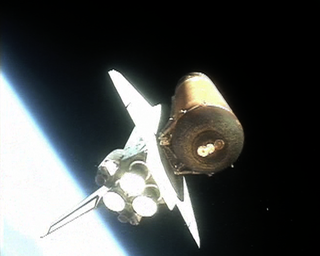
An orbital spaceflight is a spaceflight in which a spacecraft is placed on a trajectory where it could remain in space for at least one orbit. To do this around the Earth, it must be on a free trajectory which has an altitude at perigee around 80 kilometers (50 mi); this is the boundary of space as defined by NASA, the US Air Force and the FAA. To remain in orbit at this altitude requires an orbital speed of ~7.8 km/s. Orbital speed is slower for higher orbits, but attaining them requires greater delta-v. The Fédération Aéronautique Internationale has established the Kármán line at an altitude of 100 km (62 mi) as a working definition for the boundary between aeronautics and astronautics. This is used because at an altitude of about 100 km (62 mi), as Theodore von Kármán calculated, a vehicle would have to travel faster than orbital velocity to derive sufficient aerodynamic lift from the atmosphere to support itself.
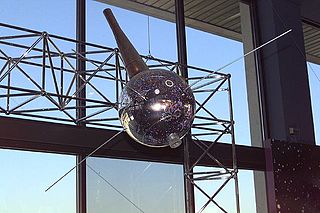
Vanguard 3 is a scientific satellite that was launched into Earth orbit by the Vanguard SLV-7 on 18 September 1959, the third successful Vanguard launch out of eleven attempts. Vanguard rocket: Vanguard Satellite Launch Vehicle-7 (SLV-7) was an unused Vanguard TV-4BU rocket, updated to the final production Satellite Launch Vehicle (SLV).

Project Echo was the first passive communications satellite experiment. Each of the two American spacecraft, launched in 1960 and 1964, were metalized balloon satellites acting as passive reflectors of microwave signals. Communication signals were transmitted from one location on Earth and bounced off the surface of the satellite to another Earth location.

The Indian Space Research Organisation is the national space agency of India, headquartered in Bangalore. It operates under the Department of Space (DOS) which is directly overseen by the Prime Minister of India, while the Chairman of ISRO acts as the executive of DOS as well. ISRO is India's primary agency for performing tasks related to space-based applications, space exploration and the development of related technologies. It is one of six government space agencies in the world which possess full launch capabilities, deploy cryogenic engines, launch extraterrestrial missions and operate large fleets of artificial satellites.

A Moon landing is the arrival of a spacecraft on the surface of the Moon. This includes both crewed and robotic missions. The first human-made object to touch the Moon was the Soviet Union's Luna 2, on 13 September 1959.
The Indian Human Spaceflight Programme (IHSP) was initiated in 2007 by the Indian Space Research Organisation (ISRO) to develop the technology needed to launch crewed orbital spacecraft into low Earth orbit. The first uncrewed flight, named Gaganyaan 1, is scheduled to launch no earlier than 2023 on an LVM 3 rocket.
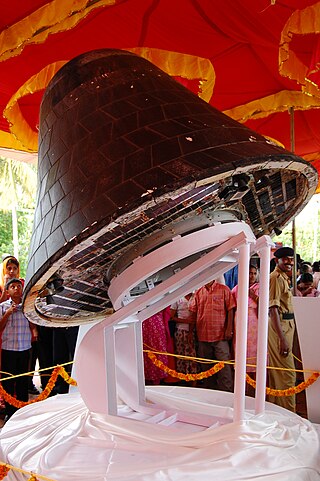
The Space Capsule Recovery Experiment is an Indian experimental spacecraft which was launched at 03:53 UTC on January 10, 2007, from Sriharikota by the Indian Space Research Organisation (ISRO). The launch was conducted using the C7 launch of the PSLV rocket, along with three other satellites. It remained in orbit for 12 days before re-entering the Earth's atmosphere and splashing down into the Bay of Bengal at 04:16 UTC on January 22.

The Living Interplanetary Flight Experiment was an interplanetary mission developed by the Planetary Society. It consisted of sending selected microorganisms on a three-year interplanetary round-trip in a small capsule aboard the Russian Fobos-Grunt spacecraft in 2011, which was a failed sample-return mission to the Martian moon Phobos. The Fobos-Grunt mission failed to leave Earth orbit and was destroyed.
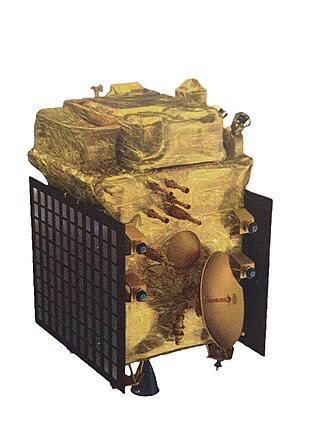
Aditya L1 is a planned coronagraphy spacecraft to study solar atmosphere, currently being designed and developed by the Indian Space Research Organisation (ISRO) and various other Indian research institutes. It will be inserted in a halo orbit around the L1 point between the Earth and the Sun where it will study the solar atmosphere, solar magnetic storms and its impact on environment around Earth.

SRMSAT is a Nanosatellite built by students at Sri Ramaswamy Memorial University(SRM Institute of Science and Technology, Chennai) in India. The satellite is an Indian Technology demonstration and Earth observation satellite which is operated by the SRM Institute of Science and Technology. This nanosatellite was used to monitor Greenhouse gases in atmosphere.
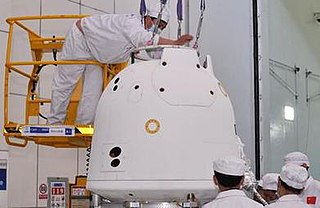
Chang'e 5-T1 was an experimental robotic spacecraft that was launched to the Moon on 23 October 2014 by the China National Space Administration (CNSA) to conduct atmospheric re-entry tests on the capsule design planned to be used in the Chang'e 5 mission. As part of the Chinese Lunar Exploration Program, Chang'e 5, launched in 2020, was a Moon sample return mission. Like its predecessors, the spacecraft is named after the Chinese Moon goddess Chang'e. The craft consisted of a return vehicle capsule and a service module orbiter.

RLV-TD is India's first uncrewed flying testbed developed for the Indian Space Research Organisation (ISRO)'s Reusable Launch Vehicle Technology Demonstration Programme. It is a scaled down prototype of an eventual two-stage-to-orbit (TSTO) reusable launch vehicle.

The Human Space Flight Centre (HSFC) is a body under the Indian Space Research Organisation (ISRO) to coordinate the Indian Human Spaceflight Programme. The agency will be responsible for implementation of the Gaganyaan project. The first crewed flight is planned for 2024 on a home-grown GSLV-III rocket.